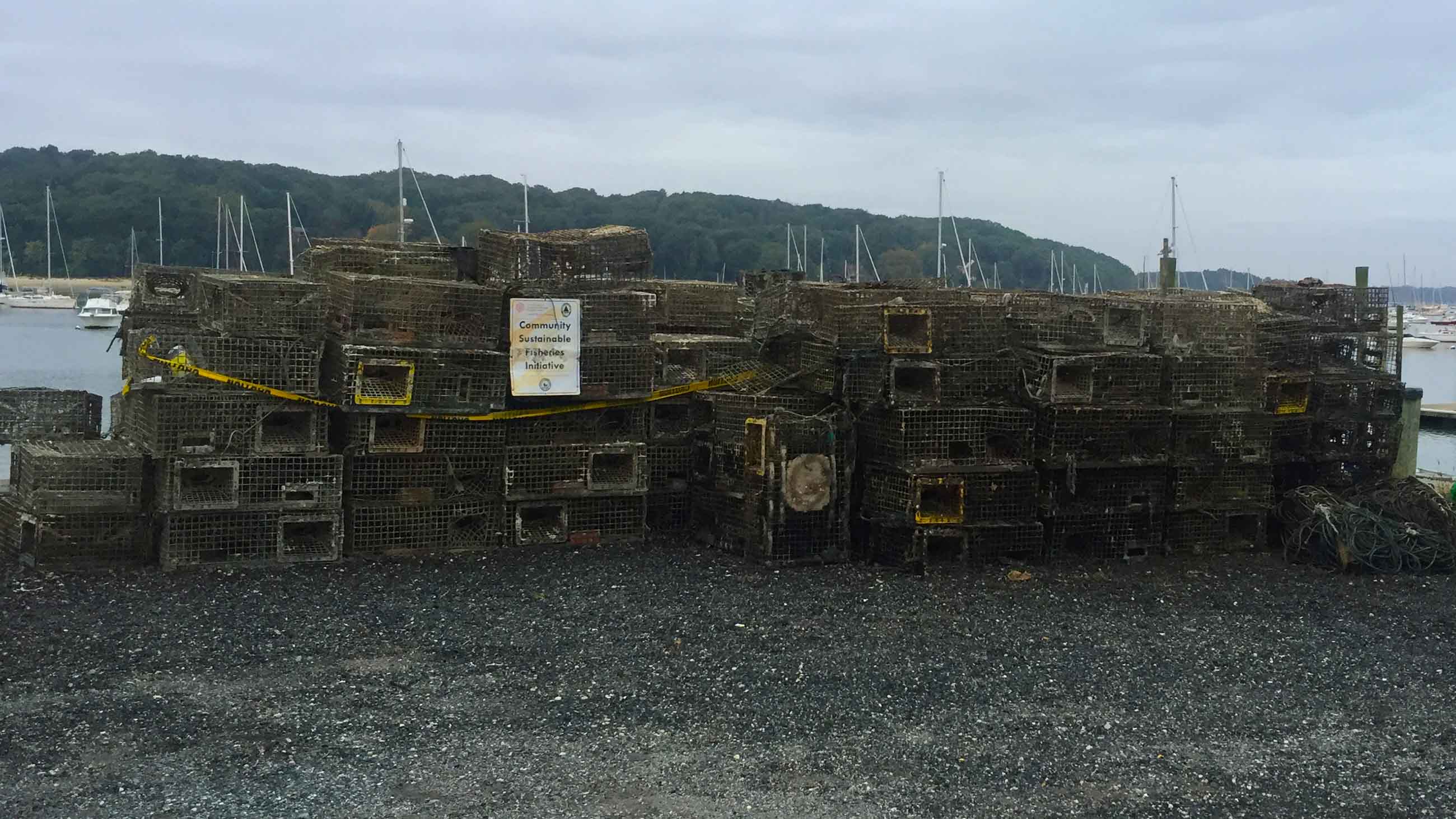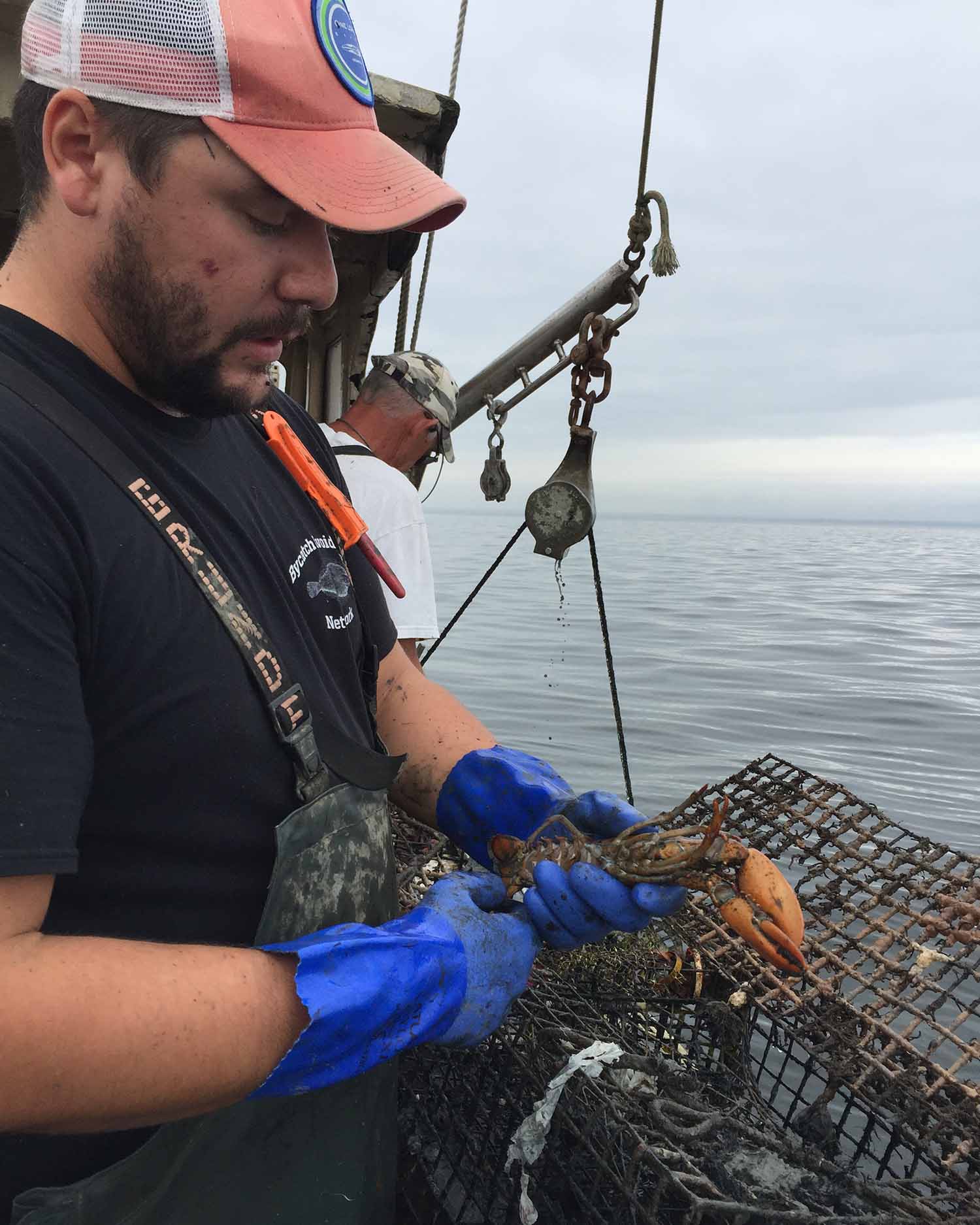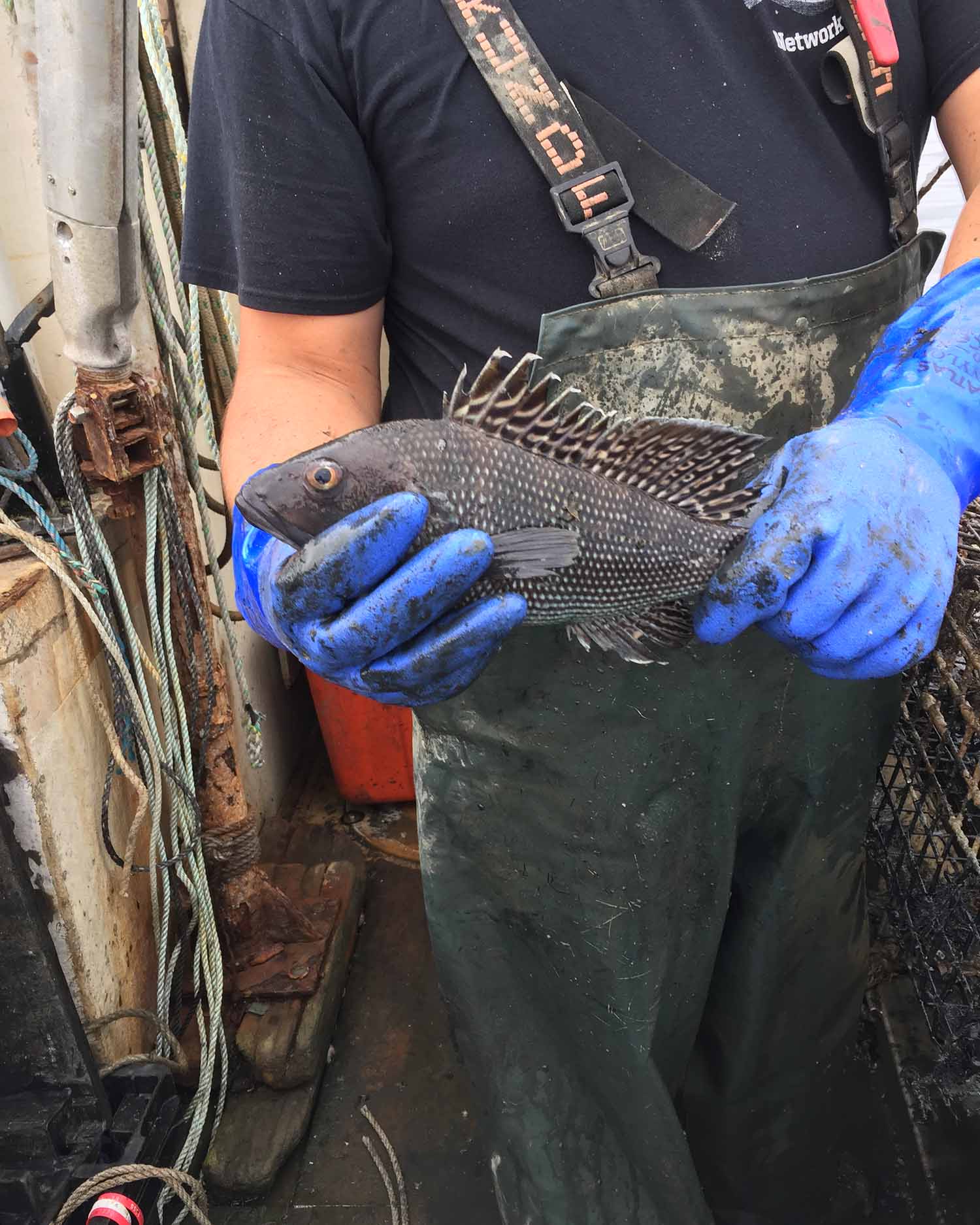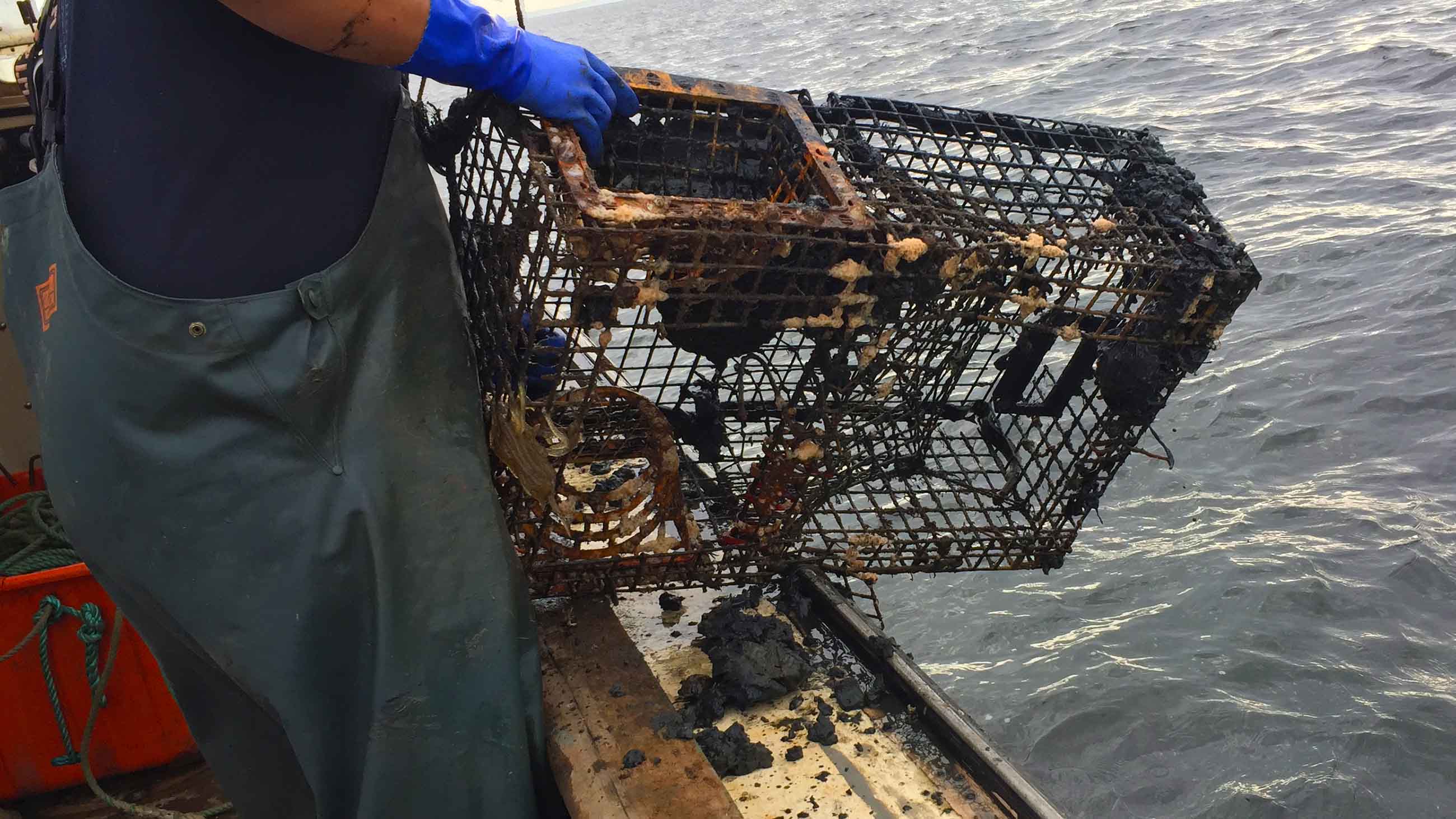Ghost Fishing Off Long Island’s Coast
On the deck of the vessel Christine & Jennifer, a dozen tiny mud crabs, each smaller than a fingertip, scuttle out of a rusty lobster trap. The crabs move sideways, exploring the edges of these newly discovered surfaces with their long thin legs. Dan Kuehn, a research technician at the Cornell Cooperative Extension, a nonprofit agency affiliated with Cornell University, inspects the next lobster pot. Something is moving among the wires.
He peers inside and says: “One undersized lobster.”
Kuehn cradles the small lobster in his hands. This one is lucky — it’s still alive. His colleague, Scott Curatolo-Wagemann, a marine biologist, uses a metal caliper to measure the creature from just above the eye socket to the junction of the tail. It’s less than three inches. Curatolo-Wagemann writes the number down, as well as the lobster’s weight, color, and sex. Then, he tosses it back in the water.
Any lobster captain would do the same with such a diminutive catch — not only is it the law, but it’s also in the fishery’s interest to preserve such a precious resource. This is particularly true in Long Island Sound, where rapid temperature increases induced by climate change, along with nitrogen pollution and disease outbreaks, have dramatically reduced the lobster population. Fisheries biologists at the Connecticut Department of Energy and Environmental Protection have noticed this decline in trawl surveys year after year, as lobster counts have dropped by 99 percent in the last two decades.
But the rusty pots now piling up on the deck of the Christine & Jennifer — abandoned years ago on the floor of the Sound — continue to catch and kill marine life, including lobsters. They call it “ghost fishing,” and the derelict gear behind it is a common problem worldwide. In 2009, a joint report of the United Nations Environment Program (UNEP) and the Food and Agriculture Organization (FAO), estimated that abandoned, lost, or otherwise discarded gear makes up about 10 percent in volume of the 705,000 tons of marine rubbish that ends up in the oceans every year. More recent publications and studies still refer to those figures.
Fishing boats may lose gear because of storms, waterway traffic, or simple forgetfulness. Others leave it behind thanks to economic or enforcement pressures. In Long Island Sound, where warming waters caused the lobster fishery to rapidly rise and fall, an estimated 760,000 to 1.3 million ghost pots clutter the ocean bottom.
In order to prevent these ghost pots from trapping the few remaining lobsters and other wildlife, researchers from the marine program of Cornell Cooperative Extension have been removing them for the past eight years. Cornell’s team has also been collecting data to understand the effect on the local lobster population, which they plan to publish next year.
Curatolo-Wagemann, the project coordinator, says that so far, out of more than 200 research trips, Cornell has retrieved about 18,000 traps. Their data show that 20 percent of the traps, or about 3,600, contained one or more lobsters — more than 100 of which were dead. But Cornell’s mortality figures are likely too conservative, as it’s hard to tell what happens underwater. When a fish or lobster dies in the pot, it doesn’t last long. Soon, it becomes a meal for other marine life, or decomposes back into the sea.
Throughout the 1990s, Long Island Sound — some 1,320 square miles of shallow estuarine water running between Connecticut and Long Island — was covered from spring to fall with buoys on top and traps on the bottom. After Maine and Massachusetts, the Sound represented the third largest lobster industry in the United States.
George Doll, the captain of the Christine & Jennifer, which was named after his daughters, remembers those days very well. He moved to Northport, Long Island, from the Bronx when he was nine. At a very young age, he began digging clams.
Around 1963, a friend dragged him into lobstering. “I didn’t think there were any lobsters around here,” Doll recalls. Then he was drafted into the army and left Long Island for a couple of years. In the meantime, his friend got quite successful in the lobster business. So, shortly after Doll returned, he bought a boat and equipment, and became a lobsterman too.
“From the late 60s into the 80s,” he says, “it kept getting better.”
Every fishermen in the area has a nickname. Doll’s is ‘Dollar.’ Fellow lobstermen gave it to him after a couple of very good days. Throughout the 80s and the 90s, in fact, the pots were “so full, you couldn’t get another thing in there,” he says. Harvest levels soon peaked: In 1998, the total catch more than tripled what it was in the mid-80s and trawl surveys registered nearly three times more lobsters. On both sides of the Sound, hundreds of people were lobstering. Those who were serious had between 400 and 2,000 pots each, says Doll. The industry generated between $18 and $40 million a year.
But the bonanza wasn’t to last. “All of a sudden something really bad happened — about 75 percent of the lobsters died in one weekend,” Doll says. “You could see dead lobsters everywhere.”
It took years — and a lot of money — to figure out what had caused the sudden die-off. Around September 17, 1999, as the remnants of Hurricane Floyd brought torrential rains at the end of a torrid summer, the mosquito-borne disease West Nile made its first appearance in the region. In New York and Connecticut, authorities sprayed a mix of resmethrin, malathion, and methoprene to contain the outbreak. Ask local fishermen and some will tell you that the heavy rain washed these pesticides into the Sound, killing the lobsters.
But in 2004, a task force of 65 researchers from 30 institutions concluded that while the pesticides may have played a role, their concentrations in most of the Sound were too low to kill the animals.
It was “a perfect storm,” the researchers wrote, of adverse environmental conditions driven by climate change. The combination of sustained high water temperatures, low dissolved oxygen — a condition which is frequent in Long Island Sound during the summer because of the high nitrogen pollution coming from the surrounding, densely populated areas — and the release of toxic emissions from the sediments, caused the crustaceans to surrender to a parasitic amoeba.
From there, the situation for the lobsters just got worse. “The die-off was only the beginning of a continued mortality event,” says Penelope Howell, a retired fisheries biologist of the Connecticut Department of Energy and Environmental Protection, who took part in the research efforts. “We saw a dramatic drop in reproduction every year following the die-off.”
By 2006, the fishery had collapsed. Lobstermen were not catching enough to cover expenses, and many quit and found other jobs. Some took their gear out of the Sound and stacked it at home, or took it to the dump in the town of Huntington. Others left their traps where they were. Just to run a boat to go and get them was too expensive, plus they would have had to hire some help. Doll adjusted to what the Sound had to offer — clams, oysters, and, more recently, conch — and continued lobstering only in the late summer which, until lately, still saw some lobsters.



In 2017, the lobster catch in New York and Connecticut generated less than $1.5 million — 3 percent of what it made in its heyday. The two states’ lobster fisheries ranked sixth and seventh in the U.S. that year, respectively, just below New Jersey.
Just a few dozen people still lobster in the Sound, mostly in July and August. This past summer, Doll didn’t even bother. He preferred harvesting shellfish. “I was paying attention to what my associates were catching,” he says, and they weren’t catching enough lobster “to let me want to put more traps out.”
By contrast, the broader U.S. lobster industry has been doing well. While the American lobster population has been declining in southern New England, in the Gulf of Maine and Canada, it has been thriving, with a total peak landed value in 2016 of $669.3 million in the U.S. and $974.8 million in Atlantic Canada.
The change represents “a net geographic shift,” says Richard Wahle, a marine scientist and director of the Lobster Institute at the University of Maine. On the Atlantic coast “the birth rate is declining and the death rate is increasing in the south,” he says, while “the opposite is true in the north.” As water temperatures are rising, the lobster population is finding its ideal comfort range further north. “We are seeing some of the highest levels in Atlantic Canada,” he adds, “especially in the Gulf of Saint Lawrence.”
Lobsters are ectotherms, which means their body temperature more or less matches their surroundings. “Their metabolism, growth, and reproduction are all tightly linked to water conditions — especially temperature,” Wahle says. The American lobster, Homarus americanus, doesn’t do well in waters above about 68 degrees Fahrenheit.
In Long Island Sound, as in other places along southern New England, bottom water temperatures have soared beyond 68 degrees Fahrenheit for an increasing number of days per year over the last two decades. Narragansett Bay in Rhode Island and both Buzzards Bay and Nantucket Sound in Massachusetts have also seen a dramatic decline in the lobster population. In addition to the heat, in all these places — and, more recently, in the southern Gulf of Maine — a shell disease has been infecting the lobster.
In the past, Howell of the Connecticut Department of Energy and Environmental Protection explains, “this animal was able to slowly expand its range to southern waters by natural selection of those genetically able to cope with warmer water.” But climate change is making temperatures rise too fast for the lobster to adapt.
In some areas, such as eastern Tasmania, where scientists have been studying the impacts on the local southern rock lobster, the ocean has warmed four times faster than the global average in the past 50 years. Rapid warming has also been observed in the northeastern U.S.: The Gulf of Maine has warmed at seven times the global average over the past 15 years. This quick rise is a combination of natural variations and how the oceans react to temperature changes — the oceans have absorbed more than 90 percent of human-induced global warming since the 1970s.
“The ocean is where the effects of climate change are in many ways appearing first,” says Malin Pinsky, an ecologist and evolutionary biologist at Rutgers University. For years, he has been tracking the speed of climate variations by following the movements of marine species in U.S. waters.
“This affects economies, this affects people’s livelihoods,” he says. “And this eventually affects our dinner plate.”
By about 11:30 am, after nearly two hours on the Christine & Jennifer, the deck is filling up. The Cornell team has dragged a 500 foot-long grapple system at least three times over a half square mile of seafloor. Each time the grappler snags debris, the team hauls it in. Each catch usually has between eight and 12 ghost traps.
After another hour, the rhythm slows. The rope is too tense — the grapple has caught a long and heavy line of pots. Doll has to divide it into two parts. He uses a buoy to signal where he leaves one half; in the meantime, he starts retrieving the other. Before he hauls each trap to the deck, he dunks it multiple times in the water to rinse off the mud. These traps must have been buried deep.
Each new line just pulls up more mud. At 1 p.m., the deck is so full that the crew can’t move beyond a small square area close to the cabin. Cornell’s team begins to wash the surfaces and tidy up. Doll looks at the stacks of pots on the deck and turns to Kuehn: “How many?”
“Sixty-seven,” Kuehn answers.
Doll blinks and goes to the helm.
In his data sheets, Curatolo-Wagemann tallies the ghost catch of the day: six lobsters, a toadfish, five black sea bass — four just in one pot — 12 rock crabs, and about four dozen spider crabs.
All three men will come back soon to retrieve more pots. They still have about 20 more trips to Central Long Island Sound to conclude this phase of the project. So far, the Cornell Cooperative Extension has removed only about 2 percent of all the estimated ghost traps infesting the Sound.
Yet, Curatolo-Wagemann feels optimistic: “We are making a dent.” The support of the local fishermen and the prospect of joining forces with new entities in Connecticut — such as the Maritime Aquarium of Norwalk — make the mission seem less impossible. But something seems sure, as Penelope Howell points out: “These traps aren’t going away anytime soon.”
Guia Baggi is an Italian journalist currently based in the U.S. She has recently specialized in science and environmental journalism at Columbia University’s Graduate School of Journalism. She loves writing about water and the changing climate, among other things.











Comments are automatically closed one year after article publication. Archived comments are below.
Wow. I had no idea about the left traps. Could the traps be bought up via a magnet?
One more: isn’t there a way to use some kind of sonar or something to locate metal objects, and do a number of sweeps and get that crap out of there? I imagine the entire oceans full of this stuff by now.
I mean 75% of lobsters in one weekend? That doesn’t make sense to connect that case to warming or storms, that sounds like an immediate event, ie chemicals
Thank you, Mary, for your contribution here.
I spent some years as an at-sea marine fisheries researcher, gathering and organizing catch data for a variety of species in industrial fishing efforts. Reflecting the topic of this article: Gear loss was regular, either from mechanical failure or from intentional abandonment, usually during rough weather. Lost or abandoned crab pots were regularly hauled up in the nets.
The fishery, although regulated, wasted species that were either unmarketable by-catch or prohibited by-catch. Their viability after being tossed overboard was close to zero. Targeted fish eventually suffocated on deck if they had not already died from de-pressurization while being hauled up, or were headed and gutted alive if they had survived to the processing lines. Subsistence fishers have caught marine life for thousands of years, but industrial fishing is not sustainable and countries should agree to end it.
Based on what I saw and did at sea, I stopped eating all marine animals (had stopped eating terrestrial animals at about age 20-21).
Fishing harms so many animals and in so many ways. All of the nutrients derived from sea life, and from animals in general, can be obtained more healthfully, humanely, and environmentally responsibly from plant sources. There are marvelous vegan versions of virtually every type of seafood, and other foods, imaginable. They’re better for us, for the other animals, and for the environment, and they’re delicious!